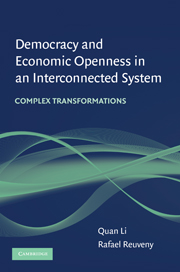Book contents
- Frontmatter
- Contents
- List of Figures and Tables
- Acknowledgments
- 1 Introduction
- PART I THE DEMOCRACY–ECONOMY NEXUS
- PART II BRINGING IN CONFLICT
- PART III BRINGING IN THE ENVIRONMENT
- 7 Democracy and the Environment
- 8 Economic Openness and the Environment
- 9 Conflict and the Environment
- 10 Conclusion
- References
- Author Index
- Subject Index
10 - Conclusion
Published online by Cambridge University Press: 05 June 2012
- Frontmatter
- Contents
- List of Figures and Tables
- Acknowledgments
- 1 Introduction
- PART I THE DEMOCRACY–ECONOMY NEXUS
- PART II BRINGING IN CONFLICT
- PART III BRINGING IN THE ENVIRONMENT
- 7 Democracy and the Environment
- 8 Economic Openness and the Environment
- 9 Conflict and the Environment
- 10 Conclusion
- References
- Author Index
- Subject Index
Summary
We are approaching the end of the intellectual journey we mapped out at the beginning of our book. Looking back, we have addressed a number of important questions, crossed various disciplinary boundaries, engaged numerous academic and policymaking controversies, and uncovered theoretical and empirical linkages among various literatures and topics, some of which have previously received little attention. The preceding eight chapters have delved into a wide range of issues that pertain to the causes or effects of democratic governance, economic openness, income inequality, economic development, military violence, and environmental degradation. In each chapter, we have focused on specific parts of the big picture, holding other things in the system constant, and have generated new knowledge, which we believe should be very useful to both academics and policy makers.
In this chapter, our goal is to bring together our key findings and draw an elaborate big picture of some of the complex transformations faced in our world today. This approach forces us to ask broader questions and cross chapter boundaries. The insights we thus generate go beyond our findings from the individual chapters. As we relax the ceteris paribus assumption underlying each chapter's analysis and connect the dots across the different chapters, we see that more processes interact and more disciplinary boundaries break down, producing new policy trade-offs and solutions.
In this chapter, we seek to accomplish three tasks. Our first task is to take stock of key findings from the various analyses we have conducted.
- Type
- Chapter
- Information
- Democracy and Economic Openness in an Interconnected SystemComplex transformations, pp. 292 - 308Publisher: Cambridge University PressPrint publication year: 2009

